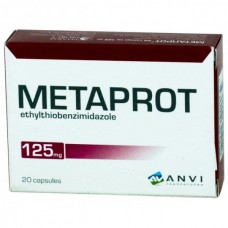Expiration date: 04/2026
Active substance: Ethylthiobenzymidazol hydrobromide
Pharmachologic effect: adaptogenic, anti-hypoxic, nootropic, antiastenic, antioxidant
Pharmacodynamics
The drug has nootropic, regenerative, antigipoksicheskoy, antioxidant and immunomodulatory activities. The mechanism of action is to activate the synthesis of RNA, and then proteins, including enzyme and related to the immune system. The activation of the synthesis of enzymes of gluconeogenesis, which provide disposal of lactate (factor limiting performance) and resynthesis of carbohydrates - a source of energy during intense stress - which leads to increased physical performance. Increased synthesis of mitochondrial enzymes and structural proteins of the mitochondria provides an increase in energy production and maintaining a high degree of coupling of oxidation and phosphorylation. Keeping a high level of ATP synthesis with the oxygen deficiency contributes expressed antigipoksicheskoy and antiischemic activity. It enhances the synthesis of antioxidant enzymes, and has a pronounced antioxidant activity. It increases the body's resistance to the effects of extreme factors: physical activity, stress, hypoxia, hyperthermia. Increases performance during physical exertion. It possesses strong antiastenicheskim action accelerates the recovery processes after extreme impacts.
Pharmacokinetics
After oral administration, is well absorbed from the gastrointestinal tract, it is extensively metabolised in the liver. After a single dose is found in the blood after 30 minutes, the maximum effect is achieved in 1-2 hours, duration -. 4-6 hours Amid course taking effect usually increases during the first 3-5 days, then steadily maintained at current levels. Prolonged kursovom continuous reception, especially at high doses, there may be a tendency to accumulation of the drug with an increase in its concentration in the blood by 10-12 th day of application.
Testimony
- increase efficiency and recovery, including in extreme conditions (heavy exercise, hypoxia, overheating);
- adaptation to the effects of various extreme factors;
- asthenic disorders of different nature (in neurasthenia, somatic diseases, after serious infections and intoxications, in pre- and postoperative period in surgical interventions);
- in the complex therapy: TBI transferred; meningitis; encephalitis; cerebrovascular accident; cognitive disorders.
Contraindications
- hypersensitivity;
- hypoglycemia;
- expressed human liver;
- epilepsy;
- arterial hypertension;
- glaucoma;
- cardiac ischemia;
- arrhythmia;
- lactase deficiency, lactose intolerance, glucose-galactose malabsorption;
- pregnancy;
- lactation;
- childhood.
Side effects
The incidence of side effects: Very common (more than 10%); frequently (10.1%); infrequently (0.1-1%); rare (0.01-0.1%); very rare (<0.01%, including isolated cases with unknown frequency).
On the part of the central nervous system: very often - headache, facial flushing, insomnia, anxiety; very rarely - paresthesia, convulsions.
From the CCC: rarely - increased blood pressure, tachycardia.
From the digestive system: rarely - nausea, vomiting, discomfort in the stomach and liver.
Allergic reactions: often - urticaria, allergic conjunctivitis, allergic rhinitis.
In the event of adverse reactions, including not listed above, you should reduce the dose or stop taking the drug and notify your doctor.
Interaction
Inhibitors of microsomal enzymes of the liver CYP1A2, CYP2C9, CYP2D6, CYP3A4 (eg cimetidine) may increase the concentration of drug in the blood.
Amplifies these positive effects PM: metabolic (including inosine), nootropic (including piracetam) antihypoxants (including trimetazidine), potassium and magnesium aspartate, glutamic acid, vitamins (incl . ?-tocopherol) and antianginal (nitrates, ?-blockers).
Dosing and Administration
Inside, after a meal.
250 mg (1 capsule. 250 mg or 2 capsules. 125 mg), 2 times a day. If necessary, the daily dose is increased to 750 mg (500 mg - 250 mg in the morning and - after lunch), patients weighing over 80 kg - 1000 mg (500 mg 2 times a day). The course of treatment - 5 days. Depending on the effect of treatment on average spend 2-3 courses (at least - 1 and 4-6), in order to avoid accumulation of the drug, it is advisable to do a two-day break between courses.
To improve performance in extreme conditions take medication for 40-60 minutes before the upcoming activity at a dose of 500-750 mg. With continued work readmission produce in 6-8 hours at a dose of 250 mg. The maximum daily dose - 1500 mg, and the next day - 1000 mg.
Overdose
Symptoms: irritability, disturbance of nighttime sleep.
Treatment: gastric lavage, the appointment of activated charcoal, symptomatic therapy. It is necessary to reduce the dose or stop taking the drug.
Special instructions
Do not take in the evening (possible violation sleep).
During treatment, it is recommended a diet rich in carbohydrates.
Storage conditions
In a dry, dark place at a temperature no higher than 25 ° C.
Keep out of the reach of children.
The shelf life: 3 years.
Do not use beyond the expiration date printed on the package.




